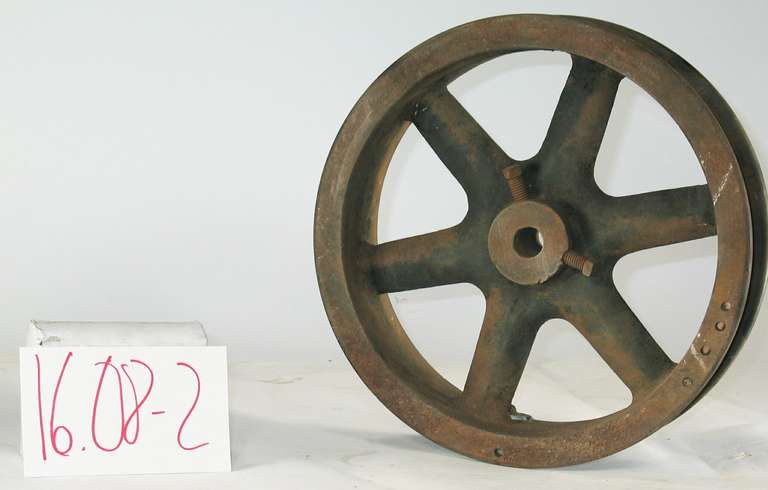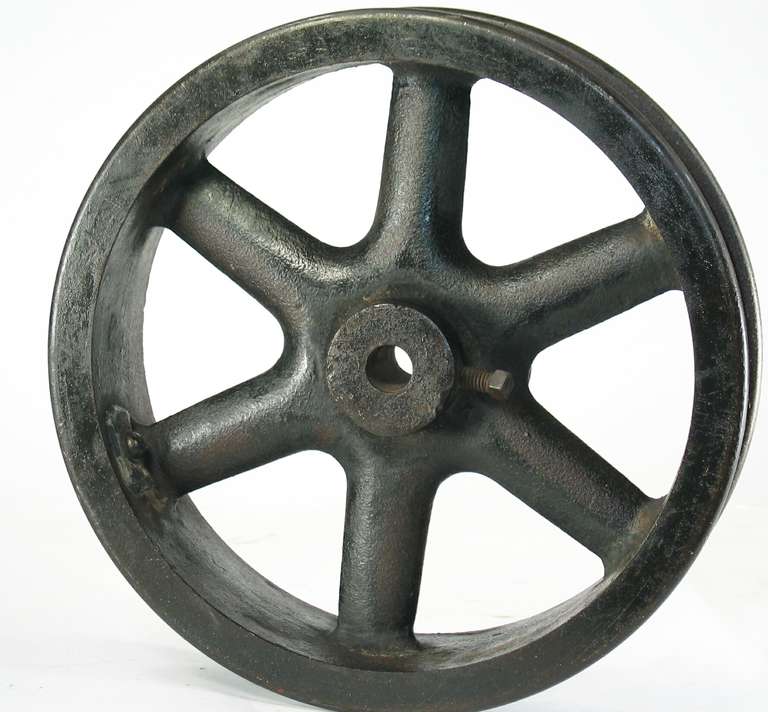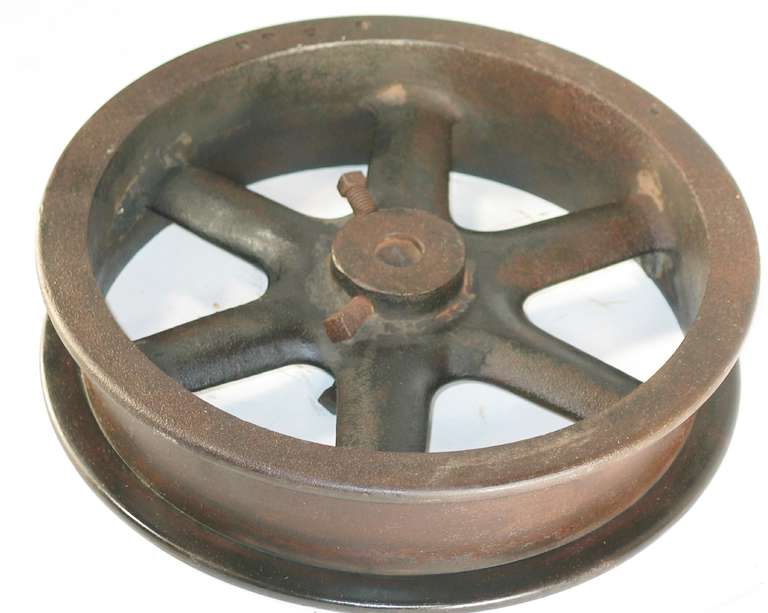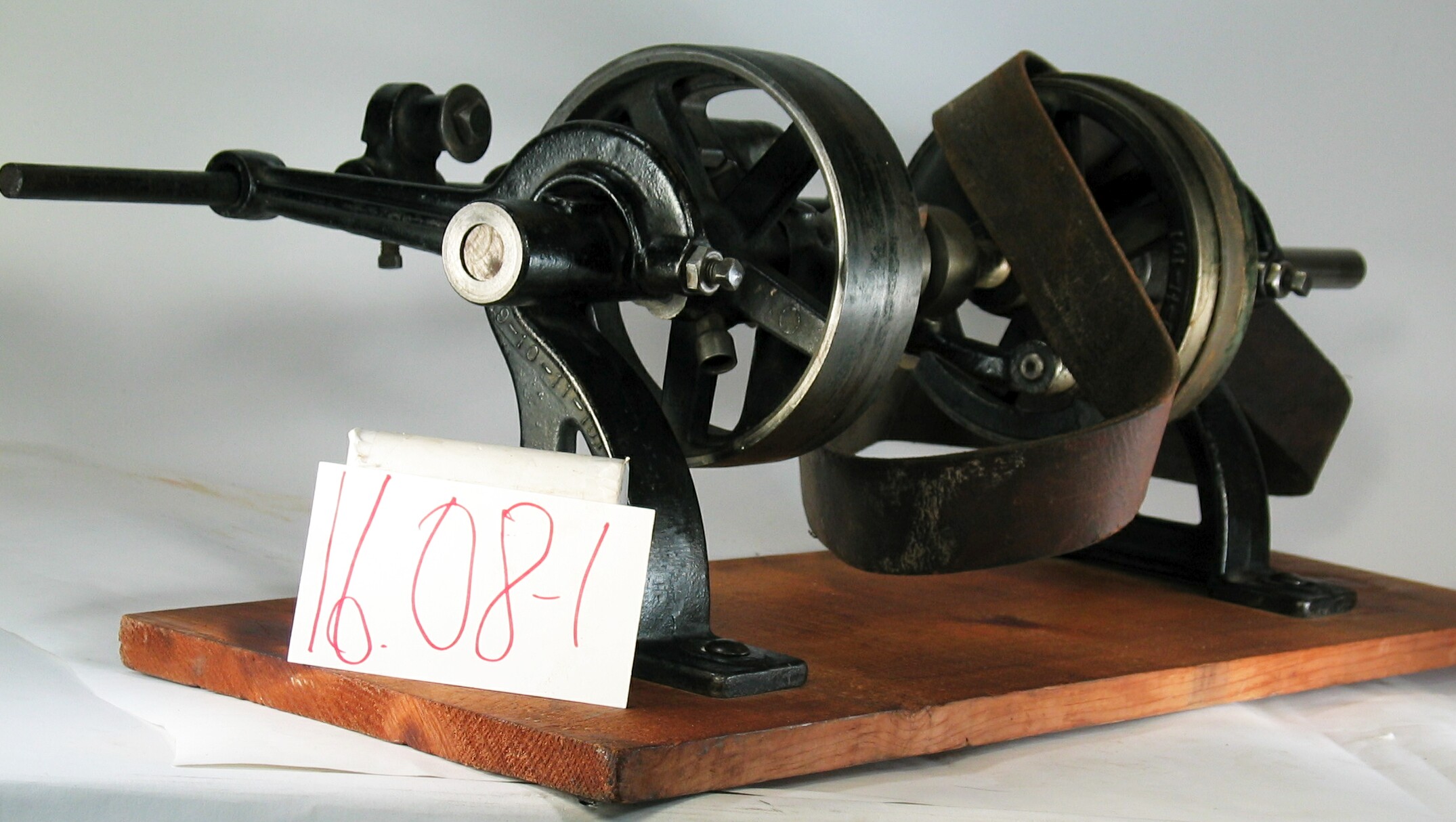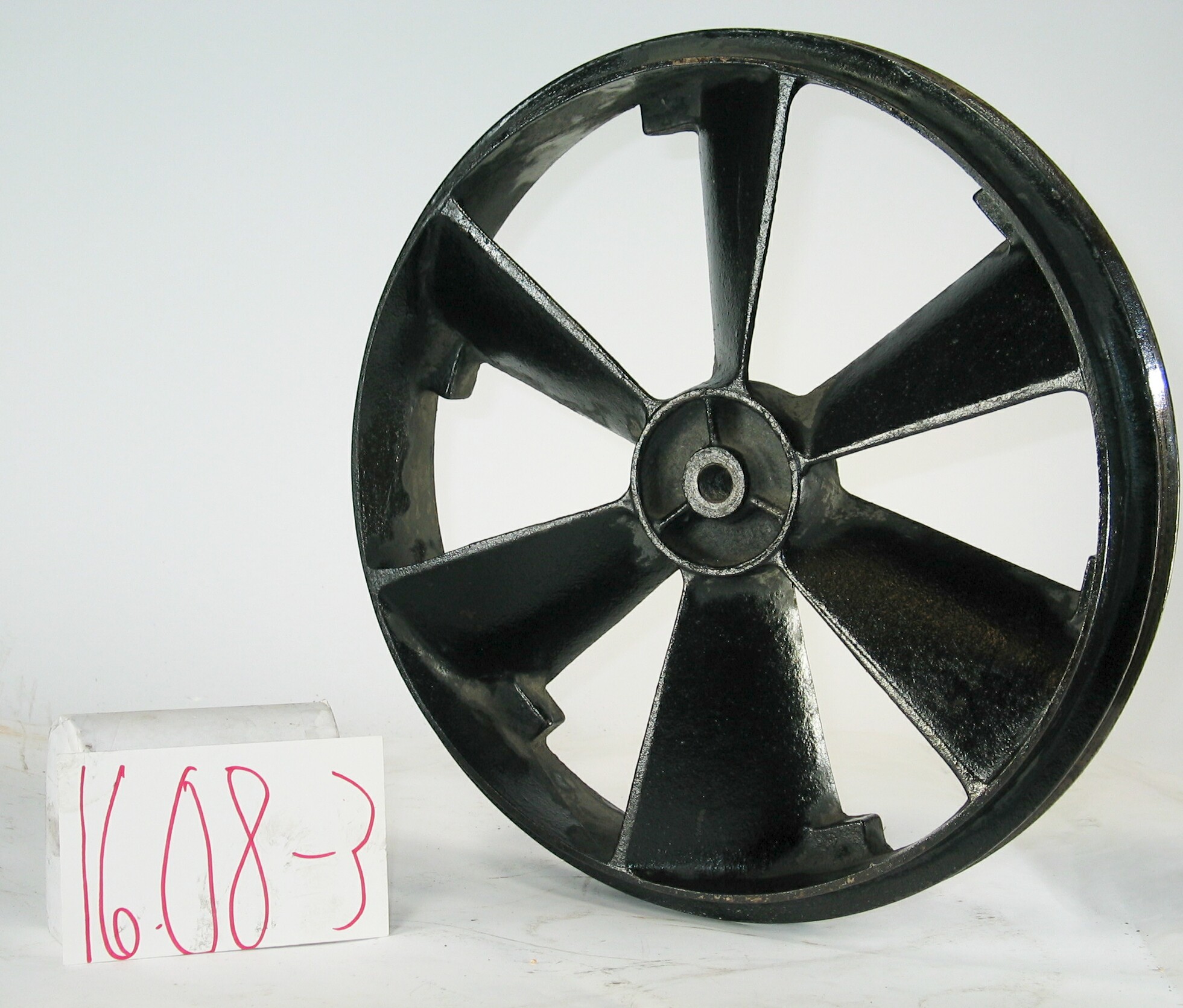16.08-2: 1915 Cast Iron Drive Pulley
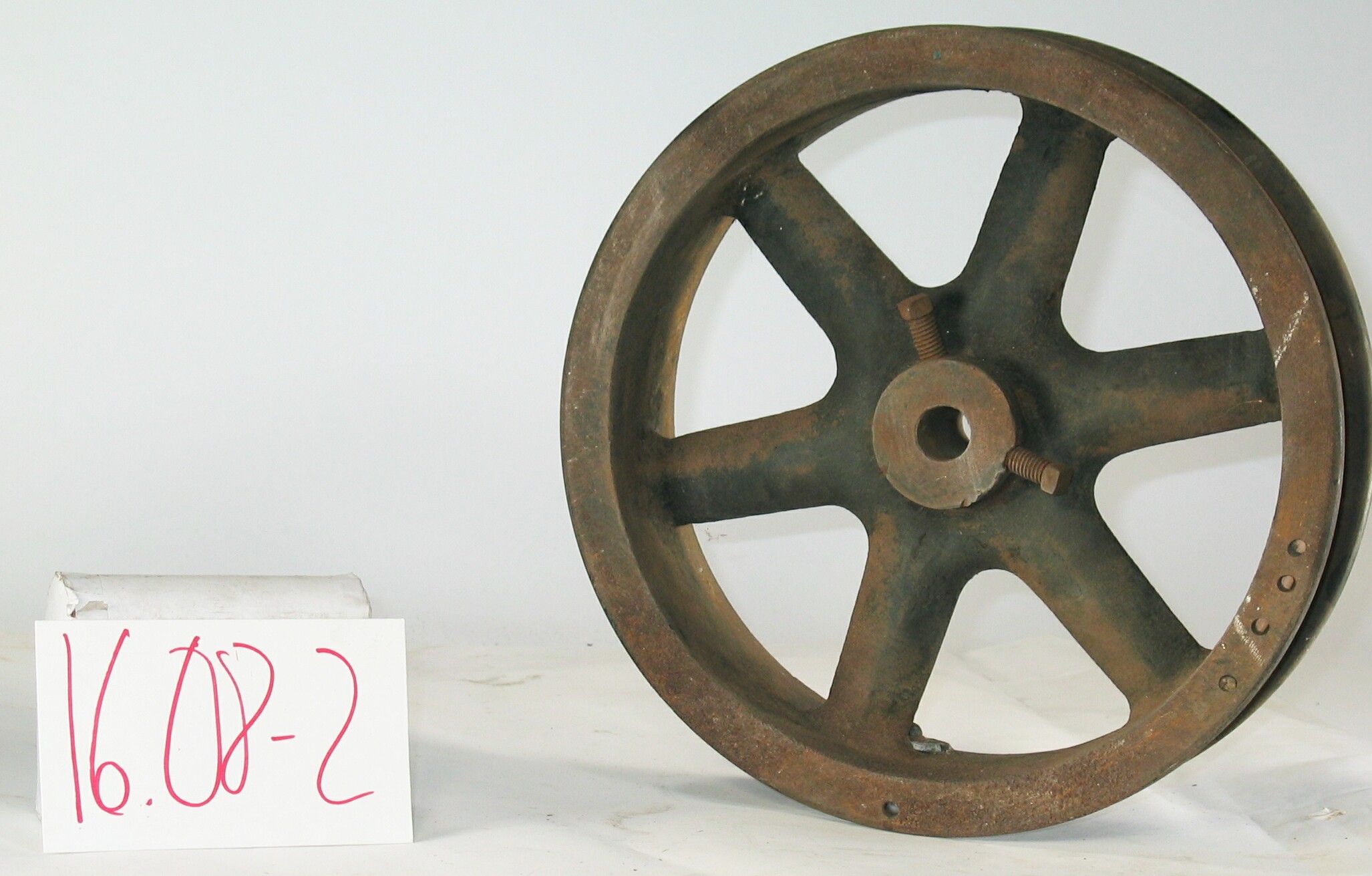
| HHCC Accession No. 2006.200 | HHCC Classification Code: 16.08-2 |
|---|
Description:
A flat belt, cast iron drive pulley, a rare piece of early motorized technology, marking the very earliest years, when the ‘engines of industry’ were being promoted for commercial enterprise and for the home. Motive power was first promoted, following the only known model, the industrial model, with remotely mounted countershaft and drive engine, linked to the labour saving machines of choice through pulleys and leather belting [see also ID# 323 and ID#325], manufacturer unknown, Circa 1915.
Group:
16.08 Electric Motors - NEC
Make:
Unknown
Manufacturer:
Model:
Serial No.:
Size:
3 inch x 11 inch round
Weight:
16 lbs.
Circa:
1915
Rating:
Exhibit, education, and research quality, illustrating the earliest years of motorized technology, as advocated for the commercial and home applications.
Patent Date/Number:
Provenance:
From York County (York Region) Ontario, once a rich agricultural hinterlands, attracting early settlement in the last years of the 18th century. Located on the north slopes of the Oak Ridges Moraine, within 20 miles of Toronto, the County would also attract early ex-urban development, to become a wealthy market place for the emerging household and consumer technologies of the early and mid 20th century.
This artifact was discovered in the 1950’s in the used stock of T. H. Oliver, Refrigeration and Electric Sales and Service, Aurora, Ontario, an early worker in the field of agricultural, industrial and consumer technology.
Type and Design:
10 inch, cat iron pulley Spoked construction ‘ with 6 cast iron spokes For ‘ inch drive shaft Twin ‘ inch set screws 2 inch drive surface for flat leather belt
Construction:
Material:
Special Features:
Accessories:
Capacities:
Performance Characteristics:
Operation:
Control and Regulation:
Targeted Market Segment:
Consumer Acceptance:
Merchandising:
Market Price:
Technological Significance:
A rare glimpse of the earliest years of the invasion of commercial establishments and the home by the ‘engines of industry’. Here, in the years before the development and popularization of affordable, FHP motors, the advocates of motorized labour saving technology envisioned the future with a single engine [internal combustion or electric] belt driven through flat belts made of leather to various pieces of labour saving equipment and appliances See Reference 5]. The ‘V’ belt drive, more efficient and compact was still to come [see ID#225]
Industrial Significance:
Socio-economic Significance:
Socio-cultural Significance:
Moving the ‘engines of industry’ in the home and places of business started with the ear-splitting noise of the internal combustion engine. By the 1920’s the principle cultural images in North America were said to be those of the engine and the mechanization that ensued. The engine had, in fact, become, in the dominant popular view, the ‘engine of progress’. It was seen everywhere, on the farm, in industry, in the shop, on the road and then, in a manner once thought not possible, in the home. A standard Canadian engineering text reported in 1946 that: ‘Ceaseless change is the keynote of the machine age and society’.Machine civilization ‘.differs from others in that it is dynamic, containing within itself the seeds of constant reconstruction’’ The authors go on to note: ‘But machine civilization based on technology, science, invention, and expanding markets must of necessity change ‘ and rapidly. The order of steam is hardly established before electricity invades it; electricity hardly gains a fair start before the internal combustion engine overtakes it.’ See Note 11 Not-with-standing a major depression and two world wars the first half of the 20th century was a period of exceptional ferment in the development and popular dissemination of FHP electric motor technology. Associated with the development were a number of driving forces, mutually supporting and interacting: Scientifically, the theoretical ground work for development of an astonishing array of electrical and electro-magnet devices had been laid by the early years of the 20th century, through the efforts of Faraday and Steinnmetz, among many others, Technologically, the work of Thomas Edison, among others, laid the foundation stones on which urban and rural electrification would proceed, enabling an new era in human experience, favoured with consumer goods and services, previously unimagined,
Economically, a favourable climate for capital investment in manufacturing capacity, methods and materials emerged, part of North America’s second industrial revolution, Socially and culturally the consumer society was born, nurtured by a pent up demand for an easier, more comfortable, pleasurable lifestyle, and the sense that 20th century electrical and electro-motive technology might be able to help. The FHP electric motor, engineered for 110 volt, single-phase house current, revolutionized life in the Canadian home. It enabled an astonishing list of appliances and labour saving devices. The revolution would take place in an astonishingly short period of time - for much of urban Canada much less than a decade. The electro-mechanical mechanization of the Canadian home was accomplished for much of urban Canada by the late 1930’s. But the early 20th century wonders of household mechanization would be dependent , in turn, on household ‘electrification’ Between them electrification and electro-mechanical mechanization changed everything. Almost over night it altered what Canadians do in the course of their day, how they live and their expectations of what their world had in store for them - in labour saving devices, devices of convenience, health and safety. The fractional horsepower electric motor [FHP] became an ubiquitous part of the Canadian household by the mid 1930’s. Cyril Veinott reported, December 1938:
‘Practically every electrified home today makes use of one or more fractional horsepower motors. This kind of motor may be used in a washing machine, refrigerator, vacuum cleaner, clock, oil burner, hair drier, room heater, sewing machine, razor, health machine, fan, air conditioner, stoker, ironed, floor waxer, or food mixer. In industrial use, the number of useful tasks performed by fractional horsepower motors is legion. In the United States alone, the value of fractional horsepower motors sold amounts to approximately $50,000,000 annually.’ See reference #1
Similarly, more than half a decade earlier Daniel Braymer had commented on the proliferation of this mind and life changing technology for home electro-mechanization. He observed that what had made it all possible was the invention of single phase alternating current motor, in a number of subtypes, small quiet, self starting, reliable and affordable motors for the home, motors which were compatible with the rapid standardization of single phase, alternating current, electrical distribution systems then spreading across north America. See reference #2 Among the types of single phase alternating current motors which quickly populated the Canadian home were: repulsion induction [see Group 16.01] for heavy duty, high starting torque applications such as refrigeration appliances; capacitor start [see Group 16.02] for advanced high torque applications, requiring quiet operation; split Phase [see Group 16.04] for light duty low starting torque applications; and shaded pole [see Group 16.04] designs for small devices such electric fans. The FHP single phase induction motor, often unobtrusive, out of sight in a dark corner, has, none-the-less, been a principle foundation stone on which Canadian, popular consumer and household technology has evolved, throughout the 20th century and into the 21st - a driving force of profound, typically un-recognized, social, cultural and economic change [See reference 6]. Electro-motive technology [the FHP motor], along with electric and electronic communications technology [the telephone and broadcast radio] would invade the Canadian home starting in the 1920’s. Throughout the balance of the 20th century these technologies would trigger a vast, new, popular consumer culture, a ‘popular technological revolution’. Yet, simply because technology has so shaped the Canadian reality, it has also shaped much profound Canadian though about the technological experience, its meaning and significance for humanity. Included among the works of Canadian writers with an international reputation are: Arthur Kroker, George Grant, Ursala Franklin, Heather Menzies, among many others [See references 7, 8, 9, and 10]. From the vantagepoint of the 21st century noted Canadian writer Jane Jacobs asks, ‘Now we stand at another monumental crossroad, as agrarianism gives way to a technology-based future. How do we make this shift without losing the culture we hold dear’ [See reference 11]
Donor:
G. Leslie Oliver, The T. H. Oliver HVACR Collection
HHCC Storage Location:
Tracking:
Bibliographic References:
‘Fractional Horsepower Electric Motors’, Cyril Veinott, McGraw Hill New York, 1948 ‘Rewinding Small Motors’, Daniel Braymer and C.C. Roe, McGraw Hill, 1932 ‘Theory and Application of Capacitor-Start Induction Motors’, G. L. Oliver, Bachelor Thesis ,University of Toronto, Session 1951-52 ‘A course in Electrical Engineering, Volume II, Alternating Current’, Chester Dawes, McGraw Hill, 1934, Starting single Phase Induction Motors, P. 362. ‘The Fractional Horsepower Motor and its Impact on Canadian Society and Culture’, G. Leslie Oliver, Material History Review, Vol. 43, Journal National Museum of Science and Technology, 1996. ‘Technology and the Canadian Mind, Innis/ McLuhan/Grant’, Arthur Kroker, New World Perspectives, 1984. ‘Technology and Empire’, George Grant, Anansi, 1969, ‘The Real World of Technology’, Ursula Franklin, Anansi, 1993. ‘Fast Forward and Out of Control’, Heather Menzies, Macmillan, 1989 ‘Dark Ages Ahead’, Jane Jacobs, Random House, 2004 ‘Engineering and Society, with Special Reference to Canada’, C. P. Young, H. A. Innis and J. H. Dales, University of Toronto Press, 1946, P.111
